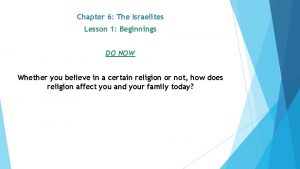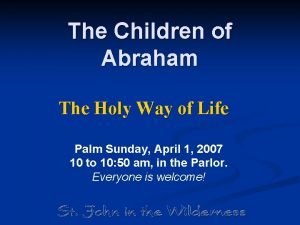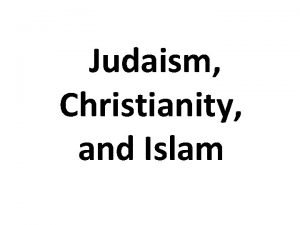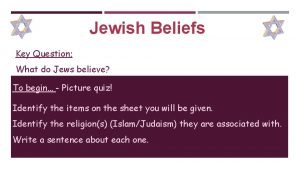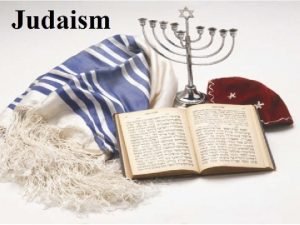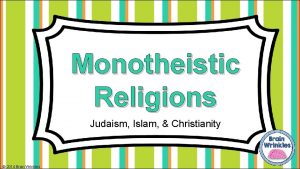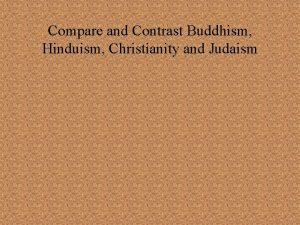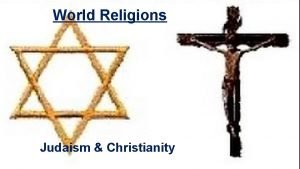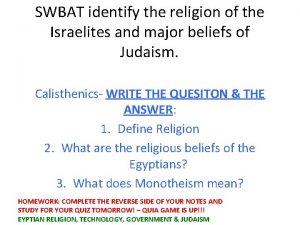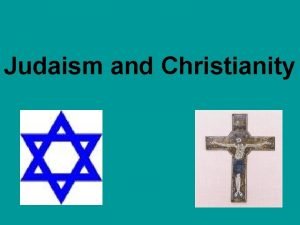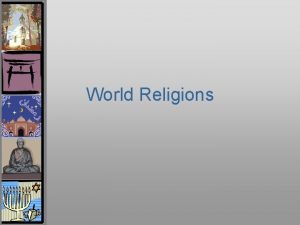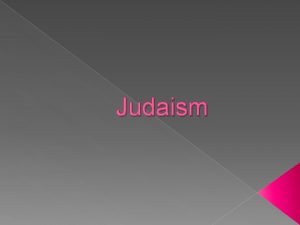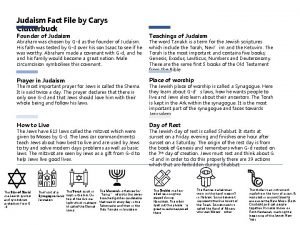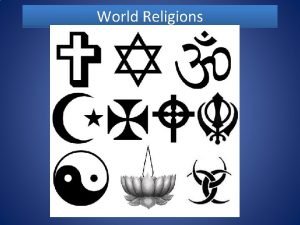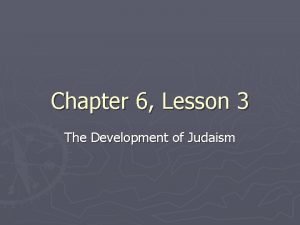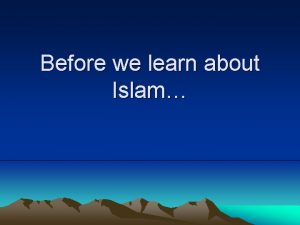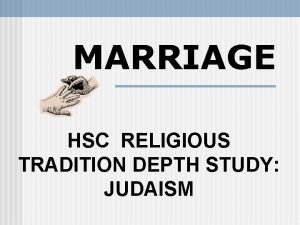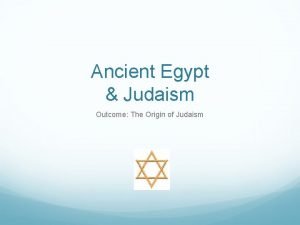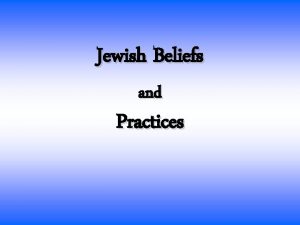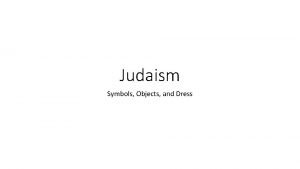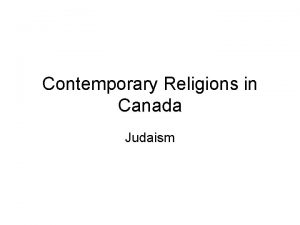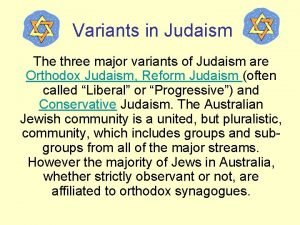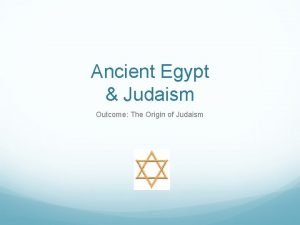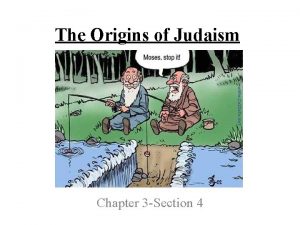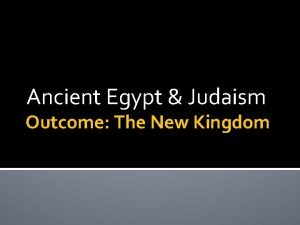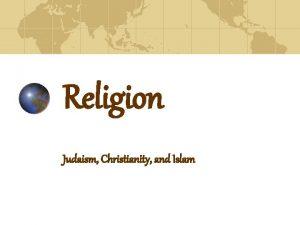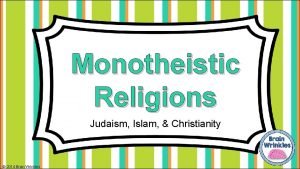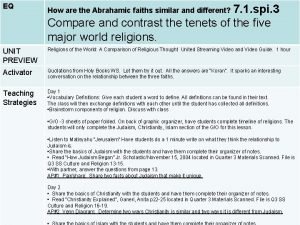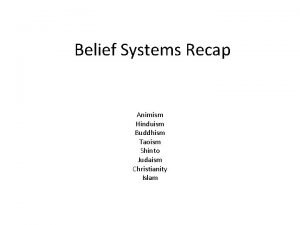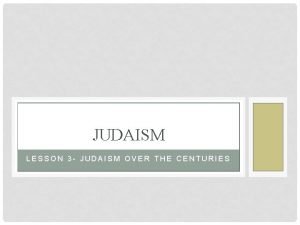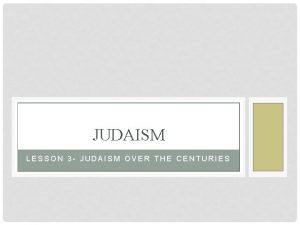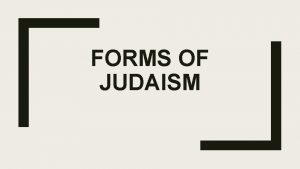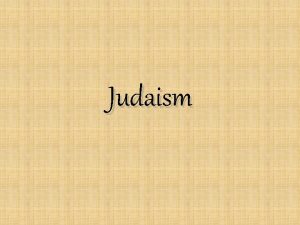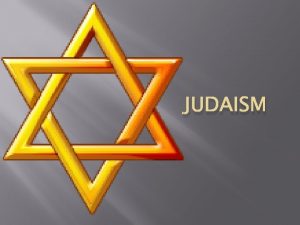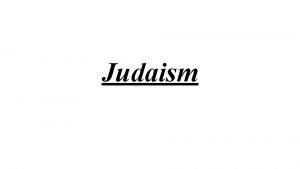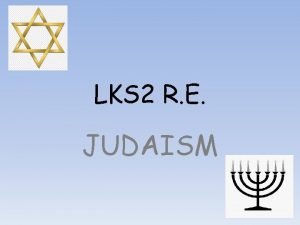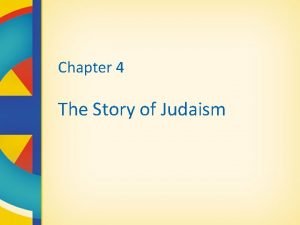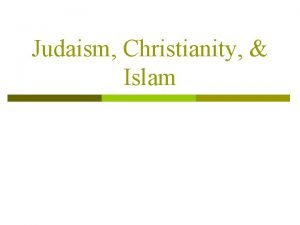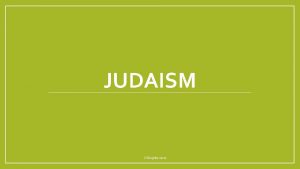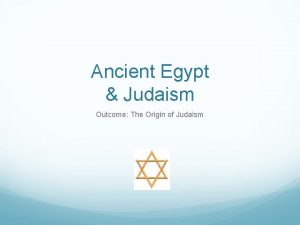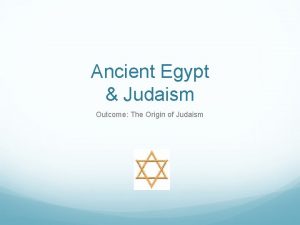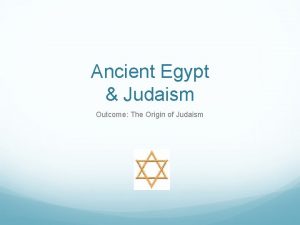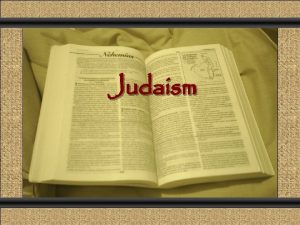The Growth of Judaism The Growth of Judaism
















































- Slides: 48

The Growth of Judaism

The Growth of Judaism

Exile and Return --- The Jews continued their religion during their exile in Babylon. --- • The Jews called their time in Babylon an exile (EHG • ZYL). This means they were forced to leave their homeland. During their exile, the Israelite religion became what we call Judaism.

• While in Babylon (BA • buh • luhn), small groups of Jews met on the Sabbath (SA • buhth). This was their weekly day of worship and rest. The Jewish Sabbath goes from sundown Friday to sundown Saturday. These weekly meetings took place at synagogues (SIH • nuh • GAHGS), or Jewish houses of worship. The synagogue meetings gave the people hope.

Why Did Jews Return to Judah? • During the 500 s B. C. , a group of people called Persians swept across southwest Asia. The Persians defeated the Chaldeans and took over Babylon. In 538 B. C. the Persian king Cyrus permitted Jews to return to Judah.

• Some Jews stayed in Babylon, but many went home. They rebuilt Jerusalem and the temple. Cyrus appointed officials to rule the country and collected taxes from the people. The Persians did not allow the Jews to have their own government or king, so the Jews depended mainly on their religious leaders—the temple priests and scribes—to run their society.

• Many scribes became religious scholars. Under a scribe named Ezra, the Jews wrote the five books of the Torah on pieces of parchment. They sewed the pieces together to make long scrolls. The Torah and writings that were added later made up the Hebrew Bible.

What Is in the Hebrew Bible? • The Hebrew Bible is really a series of 34 books collected together. The Torah, the Prophets, and the Writings that were added later make up the Hebrew Bible. Some of these books describe events in Jewish history, others are books of poetry, literature, and proverbs.

• For example, Genesis, the first book of the Torah, tells how God created the Earth in six days and rested on the seventh day. He also created the first man and woman, Adam and Eve. Genesis also tells how God punished the world for its bad behavior. In Genesis, God tells Noah to build an ark, or large boat. Noah, his family, and two of every animal on Earth boarded the ark.

• Then a great flood covered the land, and only those on the ark escaped drowning. After the flood, God promised to never again destroy the world with a flood.

• Genesis also explains why the world has many languages. It tells how the people in the city of Babel tried to build a tower to heaven. God disapproved and made the people speak in different languages, then scattered them across the Earth.

The Jews Look to the Future • Parts of the Hebrew Bible describe God’s plan for a peaceful future. The book of Daniel addresses this issue. Daniel lived in Babylon and was a trusted adviser of the king. However, he refused to worship Babylonian gods. The Chaldeans threw Daniel into a lion’s den, but God protected Daniel from the lions. The story was meant to remind Jews that God would rescue them.

Daniel in the Lion’s Den

• The Jews believed that evil and suffering would eventually be replaced by goodness. Christians and Muslims share this idea of good triumphing over evil.

The Jews and the Greeks --- Jews spread their beliefs to the Greek world and regained control of Judah. --- • In 334 B. C. a Greek king named Alexander the Great began taking over kingdoms around the Mediterranean. In 331 B. C. his armies defeated the Persians, so Judah came under his control.

• Alexander allowed the Jews to stay in Judah. However, Alexander, who loved all things Greek, introduced the Greek language and Greek ways to Judah.

What Was the Diaspora? • At the time, Jews were living throughout Alexander’s empire. Many still lived in Babylon. Some lived in Egypt and other lands around the Mediterranean Sea. The scattering of the Jews outside of Israel and Judah became known as the Diaspora (dy • AS • pruh). Diaspora is a Greek word that means “scattered. ”

• Many Jews of the Diaspora learned the Greek language and Greek ways but remained loyal to Judaism. A group of them copied the Hebrew Bible into Greek. This Greek version helped people who were not Jews to read and understand the Hebrew Bible. As a result, Jewish ideas spread throughout the Mediterranean world.

Who Were the Maccabees? • In 168 B. C. a Greek ruler named Antiochus (an • TY • uhkuhs) controlled Judah. He decided to make the Jews of Judah worship Greek gods and goddesses. A priest named Judas Maccabeus (JOO • duhs MAK • uh • BEE • uhs) and his followers rebelled. They fled to the hills and formed an army known as the Maccabees.

• After many battles, the Maccabees drove the Greeks out of Judah. They destroyed all traces of Greek gods and goddesses in their temple and rededicated it to the worship of God. Each year Jews recall the cleansing of the temple when they celebrate Hanukkah (HAH • nuh • kuh).

• Priests from Judas Maccabeus’s family became the new rulers of Judah. Under their leadership, Judah took over land that had been part of the kingdom of Israel.

The Jewish Way of Life --- Religion shaped the Jewish way of life. --- • Jewish law set out many rules for Jews to follow that affected their daily life. These laws influenced their education, the foods they ate, and even the clothes they wore. They also required Jews to provide for the poor, visit the sick, do good deeds, give to charity, and apply just laws to rich and poor alike. The laws emphasized self-control and reminded Jews of their religion.

Jewish Clothing • Jewish law forbade mixing some fabrics. So women used flax or wool to make cloth but did not combine the two. Jewish men wore tunics made of linen. Some men layered another tunic on top. In cold weather, they wore wool or sheepskin cloaks. On their heads, they wore caps or turbans. On their feet, they wore sandals.

Women draped themselves in long, simple dresses. They covered their heads with shawls. Wealthy women wore leather shoes, makeup, and jewelry.

Family Life • The Jews placed great importance on family. Sons were especially valued because they carried on the family name. Upon a father’s death, the son became head of the family.

• Education was also important. Jewish children’s first teachers were their mothers. When sons grew old enough, fathers taught them how to earn an income and to worship God. Later, elders took over the religious education of boys and taught them the Torah. Because reading the Torah was central to Jewish life, religious teachers became important community leaders.

• Mothers educated their daughters at home. The girls learned to be good wives, mothers, and housekeepers. This included learning Jewish laws about food and clothing. They also learned about the courageous women of ancient Israel. One of these women was named Ruth. Her courage and devotion to her family provided an example for Jewish girls to follow.

The Jewish Diet • Under Jewish law, Jews could eat only certain animals. For example, they could eat beef and lamb but not pork. They could eat scaly fish, like salmon, but not shellfish or smooth-skinned fish, like eels. Laws about food are known as kashrut, which means “that which is proper. ”

• Today, food that is prepared according to Jewish dietary laws is called kosher. Animals used for kosher meat must be killed in a special way. The meat must be inspected, salted, and soaked. To be kosher, Jews must not cook or eat milk products with meat.

• In ancient times, everyday meals were made up of fish, fruit, vegetables, and barley bread. Beverages included mainly milk, water, wine, and beer.

The Jews and the Romans --- Under Roman rule, the Jews were divided and rebellious. In response, the Romans destroyed the temple and exiled the Jews. --- • In 63 B. C. a people known as the Romans conquered Judah. Led by powerful generals, the Romans were intent on expanding their empire. The Roman capital was far to the west in what is today the country of Italy. When the Romans conquered Judah, they renamed it Judaea (joo • DEE • uh). At first, the Romans allowed Jewish rulers to run Judaea.

The Rule of King Herod • The most famous ruler of Judaea during this time was King Herod (HEHR • uhd). He is known for the additions he made to the Jewish temple in Jerusalem. He made the temple one of the most awe-inspiring buildings in the Roman world.

• Shortly after Herod died, the Romans replaced the Jewish king with Roman officials. The Jews were divided over the best way to deal with the Romans. Different groups had different opinions about the best course of action.

• One group of Jews was known as the Pharisees (FAR • uh • seez). They taught the Torah and that people should strictly obey its teachings. They also taught how to apply the Torah’s laws to daily life. In doing so, they helped make Judaism a religion of the home and family. The Pharisees also taught in synagogues and were supported by the common people.

• One of the main teachings that set the Pharisees apart from other groups was their support of the oral traditions. These were teachings of Jewish leaders and interpretations of Jewish writings that had been passed down over time by word of mouth. The Pharisees believed the oral traditions were very important in helping people obey the commandments.

• The Sadducees (SA • juh • SEEZ) also accepted the Torah. However, they were more concerned about how it applied to the priests in the Temple. This was because many of them were priests and scribes. They did not agree with many of the Pharisees’ teachings. For example, they did not hold to the oral traditions. Instead, they emphasized the law and commandments.

• A third group was called Essenes (ih • SEENZ). They were priests who broke away from the Temple in Jerusalem. Many Essenes lived together in the desert. They spent their lives praying and waiting for God to deliver the Jews from the Romans. Like the Sadducees, they followed the written law strictly.

• In A. D. 1947 ancient scrolls were found in caves near the Dead Sea. Because of this, they became known as the Dead Sea Scrolls. The scrolls have helped historians understand more about Judaism during Roman times.

Jewish Revolts • During the A. D. 60 s, Jewish hatred of Roman rule was at its peak. Many Jews were waiting for a messiah (muh • SY • uh), or deliverer sent by God. Other Jews known as Zealots (ZEH • luhts) wanted to fight the Romans for their freedom.

• In A. D. 66 the Zealots revolted against the Romans and drove them out of Jerusalem. Four years later, the Romans retook Jerusalem. They killed thousands of Jews and forced many others to leave. The Romans also destroyed the temple in Jerusalem. The Western Wall is all that remains of it today.

• This was a very difficult time for the Jews, but they were able to keep the city of Jerusalem. For a number of years they were able to prosper despite not being able to govern their own lands. • Eventually some Jews decided they were willing to fight for freedom again. In A. D. 132 a military leader named Simon Bar Kochba led the Jews successfully in battle against the Romans. However, three years later, the Romans crushed the revolt. Bar Kochba and many Jewish leaders were killed during the fighting.

• This time, the Romans forbade Jews to live in or even visit Jerusalem. The city was destroyed. The Romans began calling the region of Judah by the name of Palestine. This name refers to the Philistines, whom the Israelites had conquered years before.

Jewish Teachers • Despite losing their land, the Jews managed to survive. They no longer had priests. Instead, leaders called rabbis (RA • BYZ) became important. The primary role of the rabbis was to teach from the Torah to interpret its meanings, and to provide guidance to the people in their care.

• One of the most famous rabbis was Yohanan ben Zaccai (YOH • kah • nahn behn zah • KY). Zaccai was a Pharisee who had an important political influence during the Roman rule of Judaea. Although the Romans sacked Jerusalem in A. D. 70 because of the Jewish revolt, Zaccai convinced the Romans not to destroy the Jewish city of Yavneh. Instead, they allowed him to settle there and found a school to continue teaching the Jews.

• Zaccai helped Judaism survive the destruction and loss of the temple. He placed great emphasis on the study of the Torah. He also emphasized acts of loving kindness. As a result of his efforts, Zaccai’s school became a center of Torah studies for hundreds of years. Other rabbis founded Torah schools in places as far away as Babylon and Egypt.

• The rabbis wanted to save and pass on teachings about the Torah. They did this by combining their teachings into books called commentaries. The Talmud is the most important book of commentaries. It deals with almost every aspect of daily life, including agricultural activities, feasts, prayer and marriages. To this day, the Talmud remains an important record of Jewish law.

• For 2, 000 years, most Jews lived outside of Palestine. They lived throughout the Mediterranean world and migrated even farther to Southeast Asia, Central Europe, Russia, and eventually the United States. In these places, they made notable contributions to commerce, the professions, and intellectual life, and they also often faced hatred and persecution. In A. D. 1948 Palestine was divided, and a new Jewish nation called Israel was created.

Summary • During their exile in Babylon, the Jews developed their religion, which is based upon the Hebrew Bible. • Jews spread their ideas to the Greek world. About 168 B. C. , they fought the Greeks for control of Judah. • Religious laws concerning food and clothing affected everyday Jewish life. • In 63 B. C. Judah was taken over by the Roman Empire.
 Primary growth and secondary growth in plants
Primary growth and secondary growth in plants Difference between organic and inorganic growth
Difference between organic and inorganic growth Growth analysis definition
Growth analysis definition Chapter 35 plant structure growth and development
Chapter 35 plant structure growth and development Root hair structure
Root hair structure Geometric growth vs exponential growth
Geometric growth vs exponential growth Step growth polymerization vs chain growth
Step growth polymerization vs chain growth Neoclassical growth theory vs. endogenous growth theory
Neoclassical growth theory vs. endogenous growth theory 2 interesting facts about judaism
2 interesting facts about judaism Chapter 6 lesson 1 the israelites
Chapter 6 lesson 1 the israelites Orthopraxy judaism
Orthopraxy judaism Judaism christianity and islam all began in southwest asia
Judaism christianity and islam all began in southwest asia Judaism location
Judaism location Judaism beliefs
Judaism beliefs What is judaism
What is judaism Similarities of islam and judaism
Similarities of islam and judaism Monotheism chart judaism christianity islam
Monotheism chart judaism christianity islam Hinduism and judaism compare and contrast essay
Hinduism and judaism compare and contrast essay Judaism
Judaism Judaism major beliefs
Judaism major beliefs Triple venn diagram of judaism christianity and islam
Triple venn diagram of judaism christianity and islam Sacred text of judaism
Sacred text of judaism Founders of judaism
Founders of judaism Is islam universalizing or ethnic
Is islam universalizing or ethnic Which is the oldest monotheistic religion
Which is the oldest monotheistic religion Swansea synagogue
Swansea synagogue Where is hinduism located today
Where is hinduism located today Lesson 3 the development of judaism
Lesson 3 the development of judaism What is judaism
What is judaism Judaism
Judaism Primal indigenous religion ap human geography
Primal indigenous religion ap human geography Origin
Origin Daosim founder
Daosim founder Judaism branches
Judaism branches Jewish symbols
Jewish symbols Religions
Religions Jewish variants
Jewish variants Judaism place of origin
Judaism place of origin The origins of judaism chapter 3 section 4
The origins of judaism chapter 3 section 4 Key beliefs of judaism
Key beliefs of judaism Ancient egypt and judaism outcome the new kingdom
Ancient egypt and judaism outcome the new kingdom Core beliefs of judaism
Core beliefs of judaism 5 major world religions and their founders
5 major world religions and their founders Abrahamic religions
Abrahamic religions Zakzt
Zakzt Judaism founder
Judaism founder Vẽ hình chiếu đứng bằng cạnh của vật thể
Vẽ hình chiếu đứng bằng cạnh của vật thể Quá trình desamine hóa có thể tạo ra
Quá trình desamine hóa có thể tạo ra Các môn thể thao bắt đầu bằng từ đua
Các môn thể thao bắt đầu bằng từ đua









